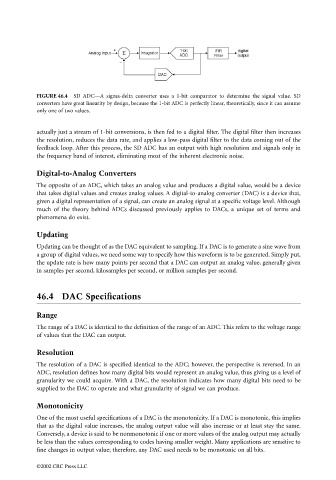Page 1191 - The Mechatronics Handbook
P. 1191
FIGURE 46.4 SD ADC—A sigma-delta converter uses a 1-bit comparator to determine the signal value. SD
converters have great linearity by design, because the 1-bit ADC is perfectly linear, theoretically, since it can assume
only one of two values.
actually just a stream of 1-bit conversions, is then fed to a digital filter. The digital filter then increases
the resolution, reduces the data rate, and applies a low-pass digital filter to the data coming out of the
feedback loop. After this process, the SD ADC has an output with high resolution and signals only in
the frequency band of interest, eliminating most of the inherent electronic noise.
Digital-to-Analog Converters
The opposite of an ADC, which takes an analog value and produces a digital value, would be a device
that takes digital values and creates analog values. A digital-to-analog converter (DAC) is a device that,
given a digital representation of a signal, can create an analog signal at a specific voltage level. Although
much of the theory behind ADCs discussed previously applies to DACs, a unique set of terms and
phenomena do exist.
Updating
Updating can be thought of as the DAC equivalent to sampling. If a DAC is to generate a sine wave from
a group of digital values, we need some way to specify how this waveform is to be generated. Simply put,
the update rate is how many points per second that a DAC can output an analog value, generally given
in samples per second, kilosamples per second, or million samples per second.
46.4 DAC Specifications
Range
The range of a DAC is identical to the definition of the range of an ADC. This refers to the voltage range
of values that the DAC can output.
Resolution
The resolution of a DAC is specified identical to the ADC; however, the perspective is reversed. In an
ADC, resolution defines how many digital bits would represent an analog value, thus giving us a level of
granularity we could acquire. With a DAC, the resolution indicates how many digital bits need to be
supplied to the DAC to operate and what granularity of signal we can produce.
Monotonicity
One of the most useful specifications of a DAC is the monotonicity. If a DAC is monotonic, this implies
that as the digital value increases, the analog output value will also increase or at least stay the same.
Conversely, a device is said to be nonmonotonic if one or more values of the analog output may actually
be less than the values corresponding to codes having smaller weight. Many applications are sensitive to
fine changes in output value; therefore, any DAC used needs to be monotonic on all bits.
©2002 CRC Press LLC

